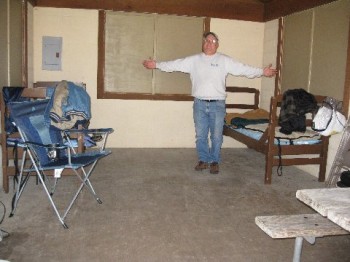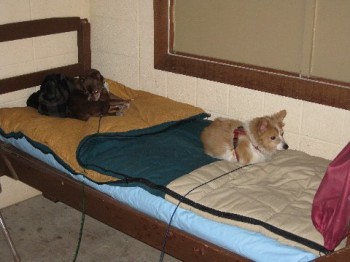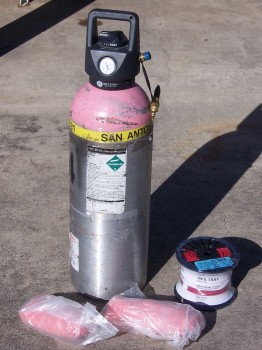 On Wednesday, April 14, 2010, AARO’s own Luke Ham (KF5CSK) achieved the Boy Scouts of America highest rank, Eagle Scout.
On Wednesday, April 14, 2010, AARO’s own Luke Ham (KF5CSK) achieved the Boy Scouts of America highest rank, Eagle Scout.
Shown with Luke are his proud parents, David (KF5BGT and also an Eagle Scout) and Lisa Ham. Click on photo for larger view.
 On Wednesday, April 14, 2010, AARO’s own Luke Ham (KF5CSK) achieved the Boy Scouts of America highest rank, Eagle Scout.
On Wednesday, April 14, 2010, AARO’s own Luke Ham (KF5CSK) achieved the Boy Scouts of America highest rank, Eagle Scout.
Shown with Luke are his proud parents, David (KF5BGT and also an Eagle Scout) and Lisa Ham. Click on photo for larger view.
April 10, 2010 – Noon until all the antennas and equipment are stowed.
Come to the Medina County Rest Stop; U.S. Hwy 90, approximately 40 miles west of the Loop 410 and Hwy 90 intersection; approximately 7 miles west of D’Hanis.
Here is their PDF flier for the event. 2010 Spring Field-Nic
Contact Walter Hock KK5LO for details kk5lo@swbell.net
![2010FieldDayLogo[1]](http://sanantoniohams.org/blog/wp-content/uploads/2010/03/2010FieldDayLogo1.jpg) The Bexar Operators Group (W5BOG) has unveiled it’s location for the 2010 ARRL Field Day event held on the last full weekend in June.
The Bexar Operators Group (W5BOG) has unveiled it’s location for the 2010 ARRL Field Day event held on the last full weekend in June.
We will be operating from Choke Canyon State Park in the “Calliham Unit” based in a shelter (cabin). In keeping with the original philosophy of what Field Day should be, we will be testing several new antenna designs and operating our rigs using deep cycle batteries charged by several banks of solar panels. If there is enough wind, we will erect our wind turbine to generate power.
Our operating class will be either 1B Batt. or 1A Batt. Nothing will be pre-planned as this is a test of our emergency communications deployment capabilities. The last time we were at this location for a “Field Day” event was in 2007 when we made several hundred contacts using just a basic “Inverted V” antenna. (2009 – Lost Maples State Park, 2008 – Mustang Island)
If you’ve read an earlier blog I posted: San Antonio Hams » Blog Archive » Little Contests For “Little Guns” , I mentioned about studying both the distance away from your anticipated contacts and propagation characteristics. When I worked both the New Mexico QSO Party and the Louisiana QSO Party, I determined my best course of action was to stay on the lower bands, concentrating on 40 meters until way after sunset when I switched to collect a few Qs on 80 meters and then back to 40.
However, this philosophy would not work with the Idaho QSO Party which I intended to compete in. Again, I’d be a low power, single op in this endeavor and being so far away from the state I wanted to work, I’d written off being awarded top operator from out of the state of Idaho. Being so far away from Idaho, I needed to rethink how I’d operate. Attempting to use propagation on my side, and in the time the contest would be starting, I decided that my best bet would be to start out on 15 meters which is always a good bet when working stations 1000+ miles away. My back up band would, of course, be 20 meters.
 We traveled to the Calliham Unit of Choke Canyon State Park, about 15 miles west of the town of Three Rivers, which is about 80 miles south of San Antonio.
We traveled to the Calliham Unit of Choke Canyon State Park, about 15 miles west of the town of Three Rivers, which is about 80 miles south of San Antonio.
After checking in, we went to our screened shelter (cabin) only to find that they all had been completely refurbished since our last visit. All the cabins had large air conditioners and two beds! No more blowing up our queen sized air mattress or lugging our window AC unit in the summer.

As you can see, they allow pets, and our two dogs quickly staked out a bed they wanted. I began the task of setting up the radio gear while my XYL, KD5YTN, Krissy, completed her chores of getting the rest of the camping gear out of the truck and assembled.
We had a problem and had a tough choice to make. It was a very windy day on Friday, with gusts over 25 mph. We decided to wait and see if the wind would die down, as was predicted for Saturday. So, we erected a 160 meter dipole antenna to work the first half of the contest. I would have preferred a loop, but we had neither the real estate nor the time to plot one out and set it up.
Read the rest of this entry »
The National Weather Service in New Braunfels has announced they are moving their regional Skywarn Net away from the 147.14 repeater to the newer 444.450 UHF repeater that is located just south of Startzville, with an antenna up at 1670 ft above sea level. That repeater has a tone of 114.8 and a POSITIVE offset. The 444.450 repeater has very wide regional coverage, equivalent to what the 147.14 repeater used to be. We’ve had folks from as far south as Wilford Hall on Lackland AFB in San Antonio, or north to south Austin on 6th Street. Of course those contacts were made using 50 watt mobile or base radios.
This repeater will soon be hooked up via an IRLP node, but the trustee Wade W5ERX is still working out the bugs for that. This repeater is being sponsored by the Hill Country REACT Team.
This Skywarn net is NOT to be confused with the local Skywarn Nets in San Antonio or Austin on the 146.94 repeaters. In San Antonio, that repeater has a PL tone of 179.9 and a negative offset. The Austin repeater has no PL tone required, but does have an output tone.
In San Antonio, most of the time, you will find one of the AEC’s (Assistant Emergency Coordinator) from the Bexar County ARES group running the local Skywarn Net, and the repeater has a tone that goes off periodically, sort of a beep, just to let you know something serious is going on even if you don’t hear anybody talking at the moment.
If the Net Control operator asks for specific types of reports, don’t call in with reports of “It’s not raining over here”, or “I just saw on TV that such and such was happening…”. Don’t clutter up the frequency with chatter.
 The Bexar Operators Group will be “Flying Pink” with a 9 foot pink weather balloon with an attached pink (ok, reddish pink) 260 foot vertical wire antenna during the 160 meter contest this weekend to show our support for breast cancer awareness.
The Bexar Operators Group will be “Flying Pink” with a 9 foot pink weather balloon with an attached pink (ok, reddish pink) 260 foot vertical wire antenna during the 160 meter contest this weekend to show our support for breast cancer awareness.
We had a choice of balloons to purchase and chose the pink colored ones (boy, do they look small un inflated) and even chose the pink topped helium tank when offered a choice of others.
Pictures of our contest operation at Choke Canyon State Park’s “Calliham Unit” will be posted next week.
If you can hear us on 160 meters (probably around 1.85 – 1.9 mhz after sunset until dawn), please either post us on “DX Summit” or other internet resources or make a QSO with us!
A large, stamped -self addressed envelope, sent to the QRZ address of W5BOG will net stations contacting us a special QSL certificate showing our support for breast cancer awareness.
Bob W2IK – W5BOG
The only good way is to use a full size antenna. It’s simple physics. I don’t care what mis-information you might have read or been told or what “miracle” antenna companies might claim.
“Ham radio operator Bob Hejl has responded to several disasters in the United States and overseas, yet he feels sidelined from helping Haitians who were devastated by the earthquake that struck there two weeks ago.
Hejl volunteered for deployment with the Amateur Radio Emergency Services in New York but wasn’t called this time. He’s resigned to listening to the scant radio signals being transmitted from Haiti as rescue operations there scale back.
Hejl is one of many ham operators across the nation who were willing to lend their equipment and expertise to aid the Jan. 12 earthquake victims. Red Cross training and hundreds of radio hours since the Alaska earthquake of 1964 have prepped him for short-notice calls to broadcast his call sign, W2IK, from the mobile equipment he keeps ready for emergency deployment.”
For the full article, including quotes from several other local ham radio operators, go to:
mlhttp://www.mysanantonio.com/news/Ham_radio_operators_ready_to_help_in_disasters.ht
W2IK
 While some of us have operated in the field under emergency conditions such as during hurricanes and just after earthquakes, most hams haven’t.
While some of us have operated in the field under emergency conditions such as during hurricanes and just after earthquakes, most hams haven’t.
I have done both, but during the recent series of Haitian earthquakes I have been, for the most part, on the “sidelines”.
I currently monitor some of the emcomm traffic coming out of the affected area by listening to the SATERN frequencies and even taking a turn at being a SATERN net control op.
Very few communications have been coming out of the country because there are presently only two amateur radio operators down there.
Hopefully, things will change if agencies get “their act together” and send communications “Jump Teams” to help send health and welfare traffic from Haiti so loved ones back in the U.S. and other countries will know that their friends/relatives in Haiti are alive. Just this simple act will relieve a lot of burden and suffering.